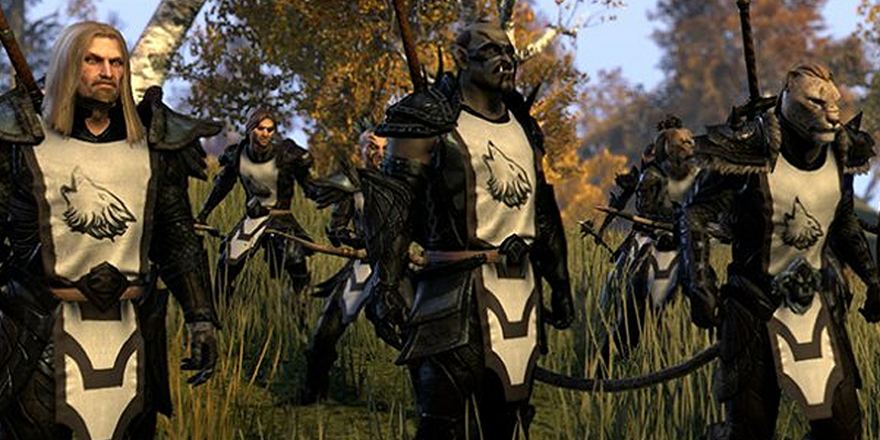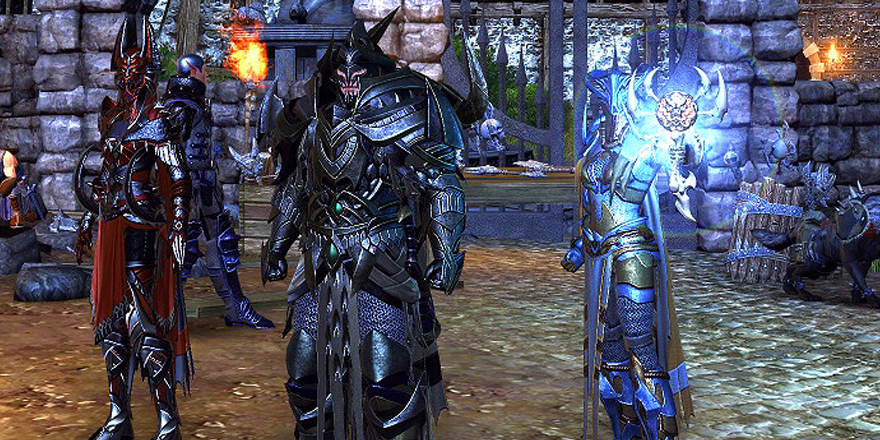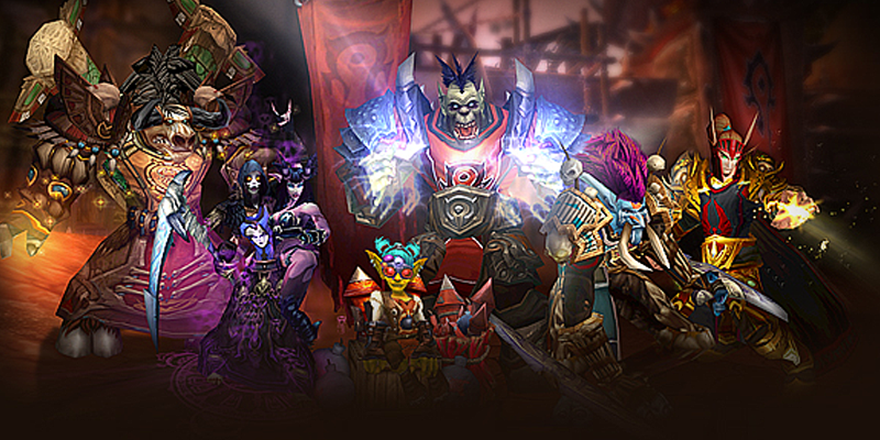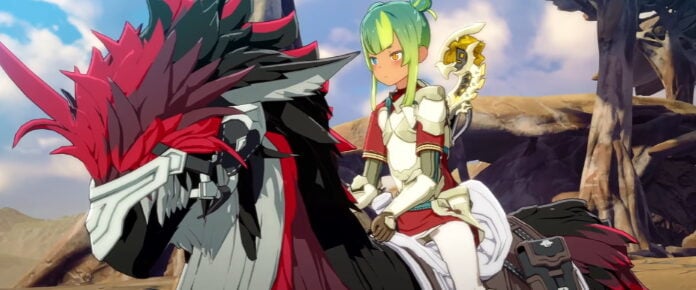
Welcome along to Guild Chat, my cozy corner of the internet in which we can discuss all things guilds, the place where we all gather to give advice to a reader in need. Come on in and pull up a plush purple couch, everybody! I’ll pop the kettle on while we get settled in, all ready to deal with this month’s issue. This edition of Guild Chat is focused on a question sent in from Massively Overpowered reader Loyheta that asks about balancing the size of a guild’s roster with its inclusiveness and activity levels. As pointed out, the balance can be hard to strike: Many of the largest guilds become somewhat fractured and cliques inevitably form, whereas smaller guilds may be very friendly but often rely on new players suiting the commonality of the existing core members. Read Loyheta’s question in full below to get up to speed, and don’t forget to pop your own two cents on the topic in the comments below.
Hey Tina, I’ve been really enjoying your articles. At this time I really only have one thing that concerns me in regards to guilds. Mainly, the types of guilds. I don’t mean focus (e.g., RP, raiding, PvP, etc.), but more behavior. In my experience there is two ends with a small grey zone that is really hard to keep. I’ve seen the large guilds that are fairly impersonal, they rely on cliques and friendships being formed from the random people they recruit. They are mostly self-serving but do play a role. Other than that I have seen the smaller, more personal guilds. They are very active or will all log in at the same time. They rely on each other to continue interest in the game. Then you get the illusive middle-ground. The large guilds that are very friendly and active. They try hosting tons of events, contests, raffles, etc.
I really would love to see an article discussing this and hearing your opinions and views on the different types of guilds, their roles, and what you would prefer. I personally have been a part of them all — the disposable healer in a raid guild (WoW), a main tank of an active RP guild (SWTOR), and the guild leader of a small social guild (GW2). I found the large but very active guild to be my personal favorite. But as I’ve mentioned, it is hard to balance. As the game became more unpopular, different officers worked their way to the top and turned it raid focus. The more active raiders that wanted to push content left for more notable raid guilds. It was nice while it lasted.
I think this is a fabulous question that’s very worthy of consideration. Most MMO players who engage in the guild experience have faced this same sort of thing. My general rule of thumb is the larger the guild, the harder it is to become a known face in the crowd; in smaller, close-knit guilds, however, it becomes more challenging to find groups that want to play the MMO at hand in exactly the same way as you, at exactly the same time, using exactly the same rules. This leaves us with the balancing act you so astutely pointed out in your email: Most players find a happy medium in a large yet cohesive guild that caters to the bulk of its membership in its activity patterns and event choices. Let’s start to unpack the guild types you describe and what they look like.

Avoiding the large, impersonal guild trap
I believe the single most important factor in guild cohesion and activity is the organic, unforced growth of the guild as controlled by active, effective guild leadership. Guild recruitment should happen naturally without mass-invite spamming newbie characters or recruiting with a lack of clear standards. Should either of these statements be true for the guild you join, it is likely you will not find a sense of togetherness in that guild’s community, as I mentioned in last month’s discussion of what players should look for in a guild. Now, when I mention “clear standards,” I’m not talking about hard experience caps, gear requirements, or other arbitrary numbers that can be used to distinguish one player from another, but rather about making clear what exactly your guild’s modus operandi is. I’m a firm believer in guild mission statements that outline what the core ethos and goals of the guild are for all members and prospective members to see. This is something that should be discussed with potential members before they join to ensure that the guild is a good fit for their playstyles and outlook, and how players emulate that mission statement should be considered during regular evaluations of the guild roster as a matter of course.
A guild leader will inevitably find himself saying no to some applicants if he follows my advice, but I don’t think that’s necessarily a bad thing. You’ll certainly have more members if you accept all the applications you receive, but how will those members’ individual outlooks affect the joint guild experience if that’s in conflict with your vision? Fractures and cliques form when certain groups of players don’t have the same vision as the rest of the guild, which leaves them with two options: leave the guild to find one that’s more suitable, or associate only with the players who run the content they wish to complete. If this striation of the member base is left unchecked, new members will find it very hard to find a place in the guild and the impersonal feel you describe will start to seep into the roster.
This guild type is good for more casual players who don’t expect a large cohesive group to be available whenever they are to run very specific content, so successful examples are usually found in the shape of large casual levelling guilds in which players of each level bracket and levelling style naturally branch off into grinding cliques to get the job done. I find that once these levelling cliques hit the level cap, they tend to leave the large, faceless guilds they met in and branch off into more niche guilds that better fit their in-game focus. I frequently had group applications from large guilds to my raiding guild as these players found that their desire to clear PvE content didn’t fit in with the intentions of the guild they levelled in.
Expanding out from the smaller niche guild
This brings me neatly back to the smaller, more personal guilds you mentioned in your query. The first guild I led started out as a tiny social enterprise in World of Warcraft: Wrath of the Lich King. I was gaming with a large group of friends at my local gaming café at the time, and since we all played in the same space, we decided to create a social guild for local players. At this point our mission was simple: We wanted to include as many local players as possible in banter-filled social play that mirrored the fun atmosphere of the place in which we played. This suited everyone because we all had the same vision and our real-life interactions shaped the guild’s ethos. We were a small, friendly guild, but how could new people break into a group that was filled with real-life friends with a unique group identity?
To me, a small guild that is largely composed of a friendship-group really suits only those specific people as their established bonds and shared history make it very hard for an outsider to infiltrate its ranks. To expand, such guilds need to slowly adapt their processes and must have a good reason for such expansion other than chasing the prestige or vanity that sometimes accompanies belonging to a large, well-known guild. Without that, new members will feel second-best to the established roster and will soon be on the hunt for a more accommodating guild.
When my guild members reached the level cap, we decided to shift it up a gear and tackle raiding on a regular basis, which necessitated attracting PUG players and advertising to fill the gaps we had in our fledgling raid team. It was at this point in our guild’s development that I started to recruit from outside of my social sphere, filling our vacancies with guildless PUGgers who gelled well with our gang. We added people from all over Europe over the course of the next few months and years, and our mission statement drastically changed to fit the new needs of the expanding guild. If it hadn’t changed, the new members we added initially would never have been able to find a meaningful place in my guild. We used both social media and a guild website to co-ordinate our members and come up with a mutually agreed timetable of events that suited the majority of our members, enabling everyone to step up and get involved in the community we created.
Successfully managing the happy medium
I was very detailed when explaining exactly what content we would tackle collectively and when that would happen, and the management structure of the guild changed to suit our needs as the guild grew. As we expanded we created more raiding teams, having four 10-man teams running concurrently to ensure that those who wished to raid were largely catered to. We also rotated our leaders between teams and had almost continual group switch-ups so that each member developed a relationship with all the leaders and a larger number of his or her guildmates, which prevented cliques from taking over the guild.
We grew into one of the elusive large-yet-cohesive guilds you mentioned, and we enjoyed our time together immensely. I feel that this guild type suits the majority of MMO players, depending on the guild’s particular gameplay emphasis, and is what many established guilds strive for. Having said that, not every guild leader wants to balance so many diverse personalities, nor can every leader dedicate the time and effort required to maintain such a constantly evolving guild. You’re most definitely correct to say that the balance wasn’t an easy one to find: There were absolutely times when I failed to treat all the members with the equality I should have in the early days because I felt pressure to keep my real-world buddies happy since I interacted with them in person on a daily basis. I wrongly prioritised them, even though they never directly asked for such preferential treatment, to the detriment of my new guildmates, causing friction between the players and contention over raiding spots and ranks.
I think using voice chat, opening up applications for new raid officers, and switching up the raid teams regularly was what helped break that bad habit. I formed such close bonds with the newer members that I stopped seeing them as additions to my “core roster” and began to recognise them as the exceptionally valuable players they really were. Our very first non-local addition to the guild brought his best friend with him and both soon became two very dear friends. Those guys are two of the wittiest, nicest idiots I’ve ever had the pleasure of knowing, but they wouldn’t have stuck with my guild if we hadn’t adapted our guild’s mission statement to fit the new type of guild we were to become. They were joined by many other phenomenal people over the guild’s lifespan as a result of our continual evaluation of both our common goals and each player we accepted into our ranks. The expansion of my guild was one of the best learning experiences I have had as a guild leader, and our progress was quite impressive for a relatively casual raiding guild as a result of what I learned from my new members.
Over to you!
What do you think, readers? Do you agree that smaller guilds suit only the members they originally catered to if they refuse to adapt to new members? Would you say that larger guilds become faceless because of a lack of clear management or commonality among their members? Have a go at unpacking this excellent question in the comments below, and don’t forget to pitch questions you’d like to see tackled in the future by email. I’d love to hear more about your guild experiences and opinions.
Thanks to Loyheta for this edition’s topic!
 MOP’s Tina Lauro is on-hand to deal with all of your guild-related questions, queries, and drama in Guild Chat. Whatever your guild issue, she’s sure to have a witty yet sympathetic response. If there’s a specific topic you’d like to see dissected, drop Tina a comment or send an email to tina@massivelyop.com.
MOP’s Tina Lauro is on-hand to deal with all of your guild-related questions, queries, and drama in Guild Chat. Whatever your guild issue, she’s sure to have a witty yet sympathetic response. If there’s a specific topic you’d like to see dissected, drop Tina a comment or send an email to tina@massivelyop.com.
















